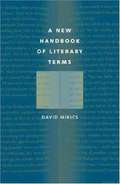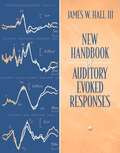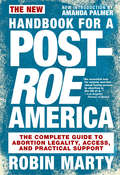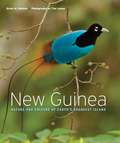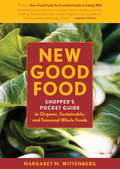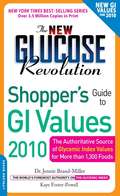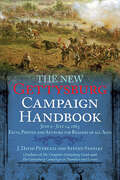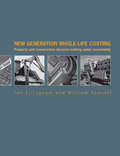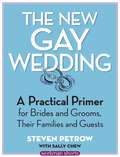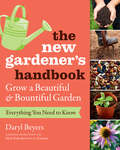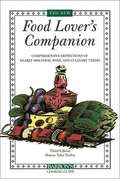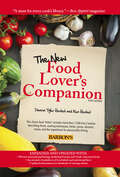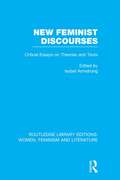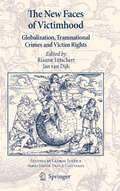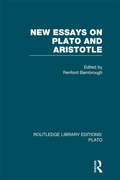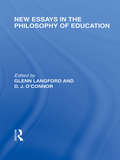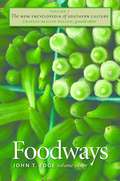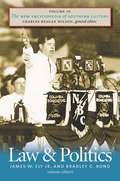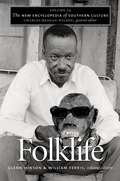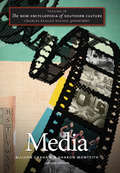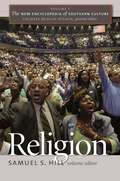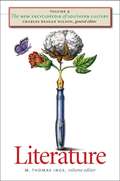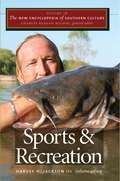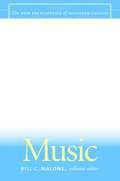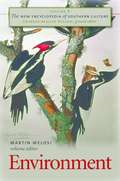- Table View
- List View
A New Handbook of Literary Terms
by David MikicsA New Handbook of Literary Terms offers a lively, informative guide to words and concepts that every student of literature needs to know. Mikics's definitions are essayistic, witty, learned, and always a pleasure to read. They sketch the derivation and history of each term, including especially lucid explanations of verse forms and providing a firm sense of literary periods and movements from classicism to postmodernism. The Handbook also supplies a helpful map to the intricate and at times confusing terrain of literary theory at the beginning of the twenty-first century: the author has designated a series of terms, from New Criticism to queer theory, that serves as a concise but thorough introduction to recent developments in literary study. Mikics's Handbook is ideal for classroom use at all levels, from freshman to graduate. Instructors can assign individual entries, many of which are well-shaped essays in their own right. Useful bibliographical suggestions are given at the end of most entries. The Handbook's enjoyable style and thoughtful perspective will encourage students to browse and learn more. Every reader of literature will want to own this compact, delightfully written guide.
New Handbook For Auditory Evoked Responses
by James HallThis practical and comprehensive sourcebook sets out to strengthen the practitioner's understanding of clinically important auditory evoked responses (AERs). It enhances understanding of the anatomy, measurement and interpretation of AERs, helps improve AER recording procedures using stimulus techniques, and introduces new evoked response patient services.
New Handbook for a Post-Roe America: The Complete Guide to Abortion Legality, Access, and Practical Support
by Robin MartyA completely new edition--with a new introduction by Amanda Palmer--of Robin Marty's best-selling manual on what to do if/when Roe v. Wade is overturned.The New Handbook for a Post-Roe America is a comprehensive and user-friendly manual for understanding and preparing for the looming changes to reproductive rights law, and getting the health care you need. Activist and writer Robin Marty guides readers through various worst-case scenarios of a post-Roe America, and offers ways to fight back, including: how to acquire financial support, how to use existing networks and create new ones, and how to, when required, work outside existing legal systems. She details how to plan for your own emergencies, how to start organizing now, what to know about self-managed abortion care with pills and/or herbs, and how to avoid surveillance. The only guidebook of its kind, The New Handbook for a Post-Roe America includes new chapters that cover the needs and tools available for pregnant people across the country. This second edition features extensively updated information on abortion legality and access in the United States, and approximately one hundred pages of new content, covering such topics as independent alternatives to Planned Parenthood, "auntie networks," taxpayer-funded abortions, and using social media wisely in the age of surveillance.
New Guinea: Nature and Culture of Earth's Grandest Island
by Bruce M. Beehler Tim LamanAn enthralling exploration of the biologically richest island on Earth, featuring more than 200 spectacular color images by award-winning National Geographic photographer Tim LamanIn this beautiful book, Bruce Beehler, a renowned author and expert on New Guinea, and award-winning National Geographic photographer Tim Laman take the reader on an unforgettable journey through the natural and cultural wonders of the world's grandest island. Skillfully combining a wealth of information, a descriptive and story-filled narrative, and more than 200 stunning color photographs, the book unlocks New Guinea's remarkable secrets like never before.Lying between the Equator and Australia's north coast, and surrounded by the richest coral reefs on Earth, New Guinea is the world's largest, highest, and most environmentally complex tropical island—home to rainforests with showy rhododendrons, strange and colorful orchids, tree-kangaroos, spiny anteaters, ingenious bowerbirds, and spectacular birds of paradise. New Guinea is also home to more than a thousand traditional human societies, each with its own language and lifestyle, and many of these tribes still live in isolated villages and serve as stewards of the rainforests they inhabit.Accessible and authoritative, New Guinea provides a comprehensive introduction to the island's environment, animals, plants, and traditional rainforest cultures. Individual chapters cover the island's history of exploration; geology; climate and weather; biogeography; plantlife; insects, spiders, and other invertebrates; freshwater fishes; snakes, lizards, and frogs; birdlife; mammals; paleontology; paleoanthropology; cultural and linguistic diversity; surrounding islands and reefs; the pristine forest of the Foja Mountains; village life; and future sustainability.Complete with informative illustrations and a large, detailed map, New Guinea offers an enchanting account of the island's unequalled natural and cultural treasures.
New Good Food Pocket Guide, rev: Shopper's Pocket Guide to Organic, Sustainable, and Seasonal Whole Foods
by Margaret M. WittenbergThis convenient pocket guide packs the knowledgeable information of the original whole foods bible into a concise, easy-to-carry format. Focusing mainly on core food products available at large-scale supermarkets and natural foods stores, easy-reference entries help shoppers navigate their many options when choosing organic, whole, local, and sustainably and ethically produced foods. An updated pocket-size edition of the definitive guide to buying, storing, and preparing whole foods. Handy charts and tables summarize what's in season when. Organic food sales totaled nearly $17 billion in 2006, up 22 percent from the previous year, in the U.S. alone. From the Trade Paperback edition.
The New Glucose Revolution Shopper's Guide to GI Values 2010: The Authoritative Source of Glycemic Index Values for More Than 1,300 Foods
by Kaye Foster-Powell Jennie Brand-MillerReference book for 1300 glycemic index values,
The New Gettysburg Campaign Handbook: Facts, Photos, and Artwork for Readers of All Ages, June 9–July 14, 1863
by Steven Stanley J. David PetruzziThe New Gettysburg Campaign Handbook is an informative full-color guide for American Civil War and Gettysburg enthusiasts of all ages. Authors J. David Petruzzi and Steven Stanley use clear and concise writing broken down into short and easy to understand chapters complete with original maps, modern and historic photographs, tables, charts, and artwork to narrate the history of the Gettysburg Campaign from the opening battle at Brandy Station in Virginia on June 9, 1863, to the escape of Gen. Robert E. Lee’s Confederate Army of Northern Virginia across the Potomac River on July 14, 1863. Chapters include quotes of interest from participants, tables and charts of the ages and seniority ranking of the generals of both sides; weather observations during the battle; a stunning photographic study of the entire campaign; a discussion of the battle’s myths and controversies; biographies of select officers, civilians, and battlefield photographers; trivia about the campaign; a comprehensive order of battle; a suggested reading list and websites; and much more. As enjoyable to look at as it is easy to use, every casual and serious student of the Civil War and Gettysburg will want a copy of The New Gettysburg Campaign Handbook as a constant companion while reading other books on the campaign—and even as a supplement and general field guide while walking the hallowed Pennsylvania ground. About the Authors: J. David Petruzzi is an award-winning Civil War cavalry historian. He is the author of many articles for a wide variety of publications, and has written or co-authored several books including: (with Eric Wittenberg) Plenty of Blame to Go Around: Jeb Stuart’s Controversial Ride to Gettysburg (Savas Beatie, 2006); (with Wittenberg and Michael F. Nugent) One Continuous Fight: The Retreat from Gettysburg and the Pursuit of Lee’s Army of Northern Virginia, July 4-14, 1863 (Savas Beatie, 2008); and (with Steven Stanley) The Complete Gettysburg Guide: Walking and Driving Tours of the Battlefield, Town, Cemeteries, Field Hospital Sites, and other Topics of Historical Interest (Savas Beatie, 2009), winner of the U.S. Army Historical Foundation’s 2009 Distinguished Writing Award, Reference Category. With Stanley, he also produced The Complete Gettysburg Guide: Audio Driving and Walking Tour, Volume One: The Battlefield (Savas Beatie, 2010). Steven Stanley lives in Gettysburg and is a graphic artist specializing in historical map design and battlefield photography. His maps, considered among the best in historical cartography, have been a longtime staple of the Civil War Trust and have helped raise millions of dollars for the Trust through their preservation appeals and interpretation projects. Steve’s maps have appeared in a wide variety of publications. Co-authored by J. David Petruzzi, Steve produced the maps and the complete design of The Complete Gettysburg Guide: Walking and Driving Tours of the Battlefield, Town, Cemeteries, Field Hospital Sites, and other Topics of Historical Interest (Savas Beatie, 2009), the winner of the U.S. Army Historical Foundation’s 2009 Distinguished Writing Award, Reference Category, as well as The Complete Gettysburg Guide: Audio Driving and Walking Tour, Volume One: The Battlefield (Savas Beatie, 2010).
New Generation Whole-Life Costing: Property and Construction Decision-Making Under Uncertainty
by William Fawcett Ian EllinghamNew Generation Whole-Life Costing presents an innovative approach to decision-making and risk management for construction and real estate. It applies the options-based approach that has revolutionized the management of uncertainty in the business world. Based on government-sponsored research at Cambridge Architectural Research Ltd., the book introduces the idea of 'lifecycle options'. The desirability of whole-life costing is widely accepted, but take-up levels have been low. One problem is that traditional techniques fail to take account of future uncertainty. In contrast, the new options-based approach considers a diversity of possible futures, and favours flexible strategies that incorporate lifecycle options. This approach leads to more cost-effective and sustainable decisions, minimizing the risk of under- or over-investment. This book is structured around realistic case studies that demonstrate the prevalence of lifecycle options. These case studies are backed up by clear presentation of basic principles and mathematical techniques allowing the book to be read either as a stimulating introduction to new concepts, or as a guide to mathematical methods.
The New Gay Wedding: A Practical Primer for Brides and Grooms, Their Families and Guests: A Workman Short
by Steven Petrow Sally ChewTimes have changed—and with them, so have the rules. Introducing a mini ebook for today’s gay and lesbian weddings and commitment ceremonies, covering what to call the event, who pays for what, and the right way to word a same-sex wedding invitation. From the nitty-gritty (what are your state’s requirements for making it legal?) to the fun-and-pretty (what to wear!), THE NEW GAY WEDDING is a handy one-stop shop for gay couples planning their big day.Packed with Q&As from brides- and grooms-to-be and their families and friends, this adaptation from STEVEN PETROW’S COMPLETE GAY & LESBIAN MANNERS covers what’s unique about gay weddings (how to find LGBT-friendly wedding vendors, the roles of family members), but also provides a practical overview of the parts that aren’t: how to save money on the venue, the purpose of rehearsal dinner, and the art and timing of the thank-you note.Steven Petrow, former president of the National Gay & Lesbian Journalists Association, is a syndicated writer on LGBT manners for The Huffington Post, Yahoo! Shine, LOGO, and the “Q” Syndicate. The same-sex wedding expert for The New York Times, he has also written for The Advocate, The Los Angeles Times, Salon, The Daily Beast, and Out.com. His previous books include The Essential Book of Gay Manners & Etiquette and When Someone You Know Has AIDS. He lives in Chapel Hill, North Carolina.About this ebook: Workman Shorts is a line of bite-size, subject-specific ebooks curated from our library of trusted books and authors.
The New Gardener's Handbook: Everything You Need to Know to Grow a Beautiful and Bountiful Garden
by Daryl Beyers&“Gardeners just starting out will earn a sense of accomplishment and a good dose of knowledge.&” —Booklist Every new gardener has to start somewhere—and the process can be intimidating. Knowing when and what to plant, how to care for the plants once they&’re in the ground, and how to keep pests and diseases away is a lot to take on. Luckily, Daryl Beyers—an expert from the New York Botanical Garden—has written what will be a go-to resource for decades to come. The New Gardener&’s Handbook is a comprehensive overview of the fundamentals of gardening, based on the introductory gardening class that Beyers teaches at NYBG. Readers will learn about soil, plant selection, propagation, planting and mulching, watering and feeding, pruning, and weeds, pests, and diseases. The information applies to both ornamental and edible plants. Featuring inspiring photography and helpful illustrations, The New Gardener&’s Handbook gives home gardeners a foundation upon which they can grow, and encourages them to apply the lessons they&’ve learned in an intuitive, natural way.
The New Food Lover's Companion (3rd edition)
by Sharon Tyler HerbstDefinitions of nearly 6000 food, drink and culinary terms, along with a pronunciation guide and 29 appendices covering a variety of subjects
The New Food Lover's Companion
by Ron Herbst Sharon Tyler HerbstThe fifth edition of this widely praised and highly esteemed reference guide has been updated with new information to reflect the way we eat in today's world. This latest version is updated to take into account our healthier lifestyles and more diverse palates, including:Over 500 new cultural listings, including Korean, Persian, and South American additionsUpdated information for hundreds of existing entriesA blood alcohol concentration chart for men and womenAn extensive breakdown of food labels and nutritional factsDepartment of Agriculture recommendations for a 2,000 calorie per day food planAmong the myriad of foods and culinary subjects defined and explained are cooking tools and techniques, meat cuts, breads, pastas, and literally everything else related to good food and enjoyable dining—a veritable food bible for the novice home-cook, culinary student, or the self-proclaimed foodie. Handy appendices cover many topics including suggestions for substituting recipe ingredients, a microwave oven conversion chart, recommended safe cooking temperatures for meats and fish, and much more.The New Food Lover's Companion is a reference guide—not a cookbook—but it includes hundreds of cooking tips plus an extensive bibliography of recommended cookbooks. More than 7200 entries plus line art are included in this seminal work.
New Feminist Discourses: Critical Essays on Theories and Texts (Routledge Library Editions: Women, Feminism and Literature)
by Isobel ArmstrongThis collection of new feminist essays represents the work of young critics researching and teaching in British Universities. Aiming to set the agenda for feminist criticism in the nineties, the essays debate themes crucial to the development of feminist thought: among them, the problems of gendered knowledge and the implications of accounts of gendered language, cultural restraints on the representation of sexuality, women’s agency, cultural and political change, a feminist aesthetics and new readings of race and class. This variety is given coherence by a unity of aim – to forge new feminist discourses by addressing conceptual and cultural questions central to problems of gender and sexual difference. The topics of discussion range from matrilinear thought to seventeenth-century prophecy; the poetry of Amelia Lanyer to Julia Margaret Cameron’s photographs; from Dorothy Richardson and Virginia Woolf to eighteenth-century colonial painting of the South Pacific; from medieval romance to feminist epistemology. The essays utilise and question the disciplines of literary criticism, art history, photography, psychoanalysis, Marxist history and post-structuralist theory.
The New Faces of Victimhood
by Jan Van Dijk Rianne LetschertBesides generating wealth, globalization makes victims, including victims of new forms of crime. In this edited book of scholarly essays, international lawyers and criminologists reflect on the legal challenges posed by these dark sides of globalization. Examples include transnational organised crime, human trafficking and corruption, cyber crimes, international terrorism, global corporate crime and cross-border environmental crimes. The authors reflect on the limits of domestic systems of justice in providing protection, empowerment and redress to the victims of these emerging forms of global insecurity. They argue for the need of better international or supra-national institutional arrangements such as legal instruments and actions of the United Nations or regional organizations such as the European Union. In part I Jan Van Dijk and Rianne Letschert present an overview of trends in criminal victimization against the backdrop of globalization using a unique set of statistical indicators. By placing this issue in the framework of the human security concept, the authors draw out its broader political and normative implications. Theologist Ralf Bodelier explains how modern communication technologies have heightened sensitivities among the general public for human insecurities anywhere in the world. In his view, a new global conscience is in the making that may become the cornerstone of international solidarity and action. Marc Groenhuijsen and Rianne Letschert describe the emergence of national and international legal and institutional arrangements to offer remedies to victims of crime in an era of globalization. In part II a selection of experts analyse the specific issues surrounding the protection and empowerment of victims of different types of international crimes such as human trafficking, organised crime/corruption, terrorism, global corporate crime and cross border environmental crimes. In part III focused attention is given to the special challenges and opportunities of protecting and assisting crime victims in cyberspace. Part IV deals with emerging victim issues in humanitarian law such as the accountability of private military companies and the implementation of the ambitious victim provisions in the statute of the International Criminal Court including the establishment of a global fund for reparations. In the final part of the book some of its core authors formulate their ideas about the international institutional arrangements that should be put in place to offer justice to the victims of globalization. A concrete proposal is made for the transformation of the United Nations 1985 Declaration on the Principles of Justice for Victims of Crime and Abuse of Power into a full-fledged UN convention. In the final chapter further proposals are made for the increased involvement of regional organisations such as the European Union in the protection of victims of global crime.
New Essays on Plato and Aristotle: Plato: New Essays On Plato And Aristotle (Routledge Library Editions: Plato)
by Renford BambroughWhat can the study of the history of ancient philosophy bring to the study of contemporary philosophical problems and questions? In New Essays on Plato and Aristotle eight distinguished philosophers address topics in Greek philosophy that are connected with current philosophical issues. All the essays are original and include Gilbert Ryle on Dialectic in the Academy and R. M. Hare on Plato’s indictment of mathematicians.
New Essays in the Philosophy of Education (International Library of the Philosophy of Education Volume 13)
by Glenn LangfordThe contributors to this collection of essays offer a stimulating and varied range of approaches to this developing area. The volume includes discussions on the concept of education and such related topics as indoctrination and the nature and scope of the theory of education. Aspects of education including the field of moral education, and issues which are reflected prominently in the curricula of such subjects as Mathematics and Science in schools and colleges are considered.
The New Encyclopedia of Southern Culture: Foodways
by John T. EdgeWhen the original Encyclopedia of Southern Culture was published in 1989, the topic of foodways was relatively new as a field of scholarly inquiry. Food has always been central to southern culture, but the past twenty years have brought an explosion in interest in foodways, particularly in the South. This volume marks the first encyclopedia of the food culture of the American South, surveying the vast diversity of foodways within the region and the collective qualities that make them distinctively southern.Articles in this volume explore the richness of southern foodways, examining not only what southerners eat but also why they eat it. The volume contains 149 articles, almost all of them new to this edition of the Encyclopedia. Longer essays address the historical development of southern cuisine and ethnic contributions to the region's foodways. Topical essays explore iconic southern foods such as MoonPies and fried catfish, prominent restaurants and personalities, and the food cultures of subregions and individual cities. The volume is destined to earn a spot on kitchen shelves as well as in libraries.
The New Encyclopedia of Southern Culture: Law and Politics
by James W. Ely Bradley G. BondVolume 10 of The New Encyclopedia of Southern Culture combines two of the sections from the original edition, adding extensive updates and 53 entirely new articles. In the law section of this volume, 16 longer essays address broad concepts ranging from law schools to family law, from labor relations to school prayer. The 43 topical entries focus on specific legal cases and individuals, including historical legal professionals, parties from landmark cases, and even the fictional character Atticus Finch, highlighting the roles these individuals have played in shaping the identity of the region. The politics section includes 34 essays on matters such as Reconstruction, social class and politics, and immigration policy. New essays reflect the changing nature of southern politics, away from the one-party system long known as the "solid South" to the lively two-party politics now in play in the region. Seventy shorter topical entries cover individual politicians, political thinkers, and activists who have made significant contributions to the shaping of southern politics.
The New Encyclopedia of Southern Culture: Folklife
by William Ferris Glenn HinsonSouthern folklife is the heart of southern culture. Looking at traditional practices still carried on today as well as at aspects of folklife that are dynamic and emergent, contributors to this volume of The New Encyclopedia of Southern Culture examine a broad range of folk traditions. Moving beyond the traditional view of folklore that situates it in historical practice and narrowly defined genres, entries in this volume demonstrate how folklife remains a vital part of communities' self-definitions. Fifty thematic entries address subjects such as car culture, funerals, hip-hop, and powwows. In 56 topical entries, contributors focus on more specific elements of folklife, such as roadside memorials, collegiate stepping, quinceanera celebrations, New Orleans marching bands, and hunting dogs. Together, the entries demonstrate that southern folklife is dynamically alive and everywhere around us, giving meaning to the everyday unfolding of community life.
The New Encyclopedia of Southern Culture: Media
by Allison Graham Sharon MonteithThis volume ofThe New Encyclopedia of Southern Cultureexamines how mass media have shaped popular perceptions of the South--and how the South has shaped the history of mass media. An introductory overview by Allison Graham and Sharon Monteith is followed by 40 thematic essays and 132 topical articles that examine major trends and seminal moments in film, television, radio, press, and Internet history. Among topics explored are the southern media boom, beginning with the Christian Broadcast Network and CNN; popular movies, television shows, and periodicals that have shaped ideas about the region, includingGone with the Wind,The Beverly Hillbillies,Roots, andSouthern Living; and southern media celebrities such as Oprah Winfrey, Truman Capote, and Stephen Colbert. The volume details the media's involvement in southern history, from depictions of race in the movies to news coverage of the civil rights movement and Hurricane Katrina. Taken together, these entries reveal and comment on the ways in which mass media have influenced, maintained, and changed the idea of a culturally unique South.
The New Encyclopedia of Southern Culture: Religion
by Samuel S. HillEvangelical Protestant groups have dominated religious life in the South since the early nineteenth century. Even as the conservative Protestantism typically associated with the South has risen in social and political prominence throughout the United States in recent decades, however, religious culture in the South itself has grown increasingly diverse. The region has seen a surge of immigration from other parts of the United States as well as from Latin America, Asia, and the Middle East, bringing increased visibility to Catholicism, Islam, and Asian religions in the once solidly Protestant Christian South. In this volume of The New Encyclopedia of Southern Culture, contributors have revised entries from the original Encyclopedia on topics ranging from religious broadcasting to snake handling and added new entries on such topics as Asian religions, Latino religion, New Age religion, Islam, Native American religion, and social activism. With the contributions of more than 60 authorities in the field--including Paul Harvey, Loyal Jones, Wayne Flynt, and Samuel F. Weber--this volume is an accessibly written, up-to-date reference to religious culture in the American South.
The New Encyclopedia of Southern Culture: Literature
by M. Thomas IngeOffering a comprehensive view of the South's literary landscape, past and present, this volume of The New Encyclopedia of Southern Culture celebrates the region's ever-flourishing literary culture and recognizes the ongoing evolution of the southern literary canon. As new writers draw upon and reshape previous traditions, southern literature has broadened and deepened its connections not just to the American literary mainstream but also to world literatures--a development thoughtfully explored in the essays here.Greatly expanding the content of the literature section in the original Encyclopedia, this volume includes 31 thematic essays addressing major genres of literature; theoretical categories, such as regionalism, the southern gothic, and agrarianism; and themes in southern writing, such as food, religion, and sexuality. Most striking is the fivefold increase in the number of biographical entries, which introduce southern novelists, playwrights, poets, and critics. Special attention is given to contemporary writers and other individuals who have not been widely covered in previous scholarship.
The New Encyclopedia of Southern Culture: Sports and Recreation
by Harvey H. JacksonWhat southerners do, where they go, and what they expect to accomplish in their spare time, their "leisure," reveals much about their cultural values, class and racial similarities and differences, and historical perspectives. This volume of The New Encyclopedia of Southern Culture offers an authoritative and readable reference to the culture of sports and recreation in the American South, surveying the various activities in which southerners engage in their nonwork hours, as well as attitudes surrounding those activities.Seventy-four thematic essays explore activities from the familiar (porch sitting and fairs) to the essential (football and stock car racing) to the unusual (pool checkers and a sport called "fireballing"). In seventy-seven topical entries, contributors profile major sites associated with recreational activities (such as Dollywood, drive-ins, and the Appalachian Trail) and prominent sports figures (including Althea Gibson, Michael Jordan, Mia Hamm, and Hank Aaron). Taken together, the entries provide an engaging look at the ways southerners relax, pass time, celebrate, let loose, and have fun.
The New Encyclopedia of Southern Culture: Music
by Bill C. MaloneSouthern music has flourished as a meeting ground for the traditions of West African and European peoples in the region, leading to the evolution of various traditional folk genres, bluegrass, country, jazz, gospel, rock, blues, and southern hip-hop. This much-anticipated volume in The New Encyclopedia of Southern Culture celebrates an essential element of southern life and makes available for the first time a stand-alone reference to the music and music makers of the American South.With nearly double the number of entries devoted to music in the original Encyclopedia, this volume includes 30 thematic essays, covering topics such as ragtime, zydeco, folk music festivals, minstrelsy, rockabilly, white and black gospel traditions, and southern rock. And it features 174 topical and biographical entries, focusing on artists and musical outlets. From Mahalia Jackson to R.E.M., from Doc Watson to OutKast, this volume considers a diverse array of topics, drawing on the best historical and contemporary scholarship on southern music. It is a book for all southerners and for all serious music lovers, wherever they live.
The New Encyclopedia of Southern Culture: Environment
by Martin MelosiFrom semitropical coastal areas to high mountain terrain, from swampy lowlands to modern cities, the environment holds a fundamental importance in shaping the character of the American South. This volume of The New Encyclopedia of Southern Culture surveys the dynamic environmental forces that have shaped human culture in the region--and the ways humans have shaped their environment. Articles examine how the South's ecology, physiography, and climate have influenced southerners--not only as a daily fact of life but also as a metaphor for understanding culture and identity. This volume includes ninety-eight essays that explore--both broadly and specifically--elements of the southern environment. Thematic overviews address subjects such as plants, animals, energy use and development, and natural disasters. Shorter topical entries feature familiar species such as the alligator, the ivory-billed woodpecker, kudzu, and the mockingbird. Also covered are important individuals in southern environmental history and prominent places in the landscape, such as the South's national parks and seashores. New articles cover contemporary issues in land use and conservation, environmental protection, and the current status of the flora and fauna widely associated with the South.
